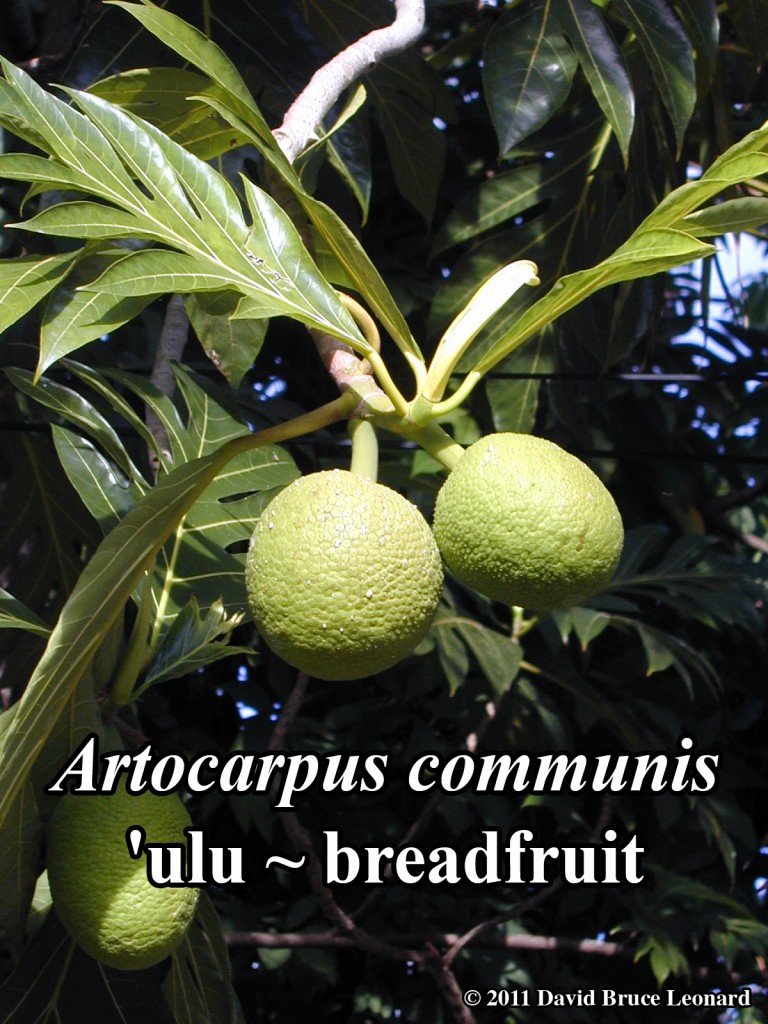Skip to content
Artocarpus communis
 PLANT NAME: Artocarpus communis
PLANT NAME: Artocarpus communis
OTHER NAMES: A. altilis, A. incisa
SIMILARLY USED SPECIES: A. odoratissinus, A. elasticus, A. elastica, A. mariannensis, A. integer, A. cumingiana, A. lakoocha, A. elastica, A. vrieseanus.
COMMON NAMES: ‘Ulu [Hawai’i]; breadfruit [English]; fruit a pain [French]; fruta pao, pao de massa [Portuguese]; broodvrucht, broodboom [Holland]; pan de ano, pan de palo, topan [Venezuela]; mazapan (seedless), castana (with seeds) [Guatemala, Honduras]; marure [Peru]; castano de malabar (with seeds) [Yucatan]; panapen (seedless), pana de pepitas (with seeds) [Puerto Rico]; timadang, kadazan, dusun (A. odoratissinus) [Borneo]; suku (seedless), kulur (with seeds) [Malaya & Java]; sa-ke, [Thailand]; rimas (seedless) [Philippines].
NOMENCLATURE: It doesn’t resemble bread, nor does it taste like a fruit.
FAMILY: Moraceae (Mulberry family).
PLANT PART USED: All of it. The male flowers are called ule’ulu (breadfruit penis), and the female flowers are called ‘ulupua (breadfruit flower).
Status: Polynesian introduction
Habitat: Likes it hot and moist
WESTERN FUNCTIONS REPORTED: Anodyne (A. altilis) [Trinidad]; antibacterial (root bark); antitumor; aperient (A. elastica) [Malaya]; astringent (root) [Pacific Islands]; contraceptive (A. elastica) [Java]; hemolytic (leaves); laxative (A. altilis) [Dominican Republic]; masticatory (A. cumingiana); purgative (root) [Pacific Islands]; styptic (A. cumingiana); vermifuge (A. communis) [Samoa].
OTHER MEDICINAL USES • Recurring illness [Tonga (bark)]. • Abdominal pain [Cook Islands (crushed stem tips internal)].
USE AS FOOD: • The uses of breadfruit as food are unlimited, although in old Hawai’i it was not a primary food but a secondary one. It was made into poi, baked in an imu (underground “oven”), and over ripe ‘ulu was also made into a pudding called pepeie’e ‘ulu. This could be dried and if put in the sun occasionally it could last for months.
-
‘Ulu may be eaten ripe as a fruit or unripe as a vegetable, although (caveat emptor) some varieties can cause vomiting if eaten raw.
-
Ripe pulp is mixed with coconut milk, salt and sugar to make a pudding.
-
In Melanesia and New Guinea, ‘ulu seeds are called “breadnut” and are roasted or boiled like a chestnut.
-
It was possibly used as baby food. The fallen male flower spikes are sometimes candied.
-
In other parts of Polynesia, ‘ulu was specially prepared by a young male and stored in pits (called mä) and lined with Cordyline spp. ( lä’ï) leaves as a hedge against famine. The breadfruit would ferment and could last years. The young man who would mash the breadfruit with his feet had to be specially circumcised and abstain from sex.
-
A delicious use of breadfruit is to steam it, marinate it in coconut water or coconut milk and orange juice, and then lightly sauté it.
-
In Barbados and Brazil highly nutritious breadfruit flour is mixed with wheat flour and made into bread. In Jamaica the flour is made into breakfast porridge.
TOXICITY: None noted
CAUTIONS AND CONTRAINDICATIONS: Some varieties of ‘ulu are purgative if eaten raw.

 PLANT NAME: Artocarpus communis
PLANT NAME: Artocarpus communis
